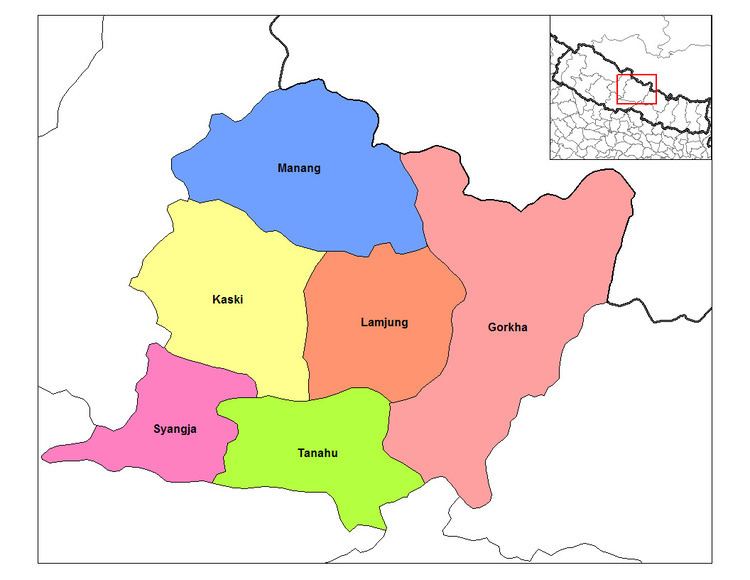Time zone Nepal Time (UTC+5:45) | ||
 | ||
Colleges and Universities Gandaki College of Engineering and Sciences Points of interest Machapuchare, Annapurna Circuit, Phewa Lake, International Mountain Museum, Begnas Lake Destinations Pokhara, Sarankot, Dhampus, Ghandruk, Bandipur | ||
Gandaki zone (Nepali: गण्डकी अञ्चल Listen is one of the fourteen zones of Nepal, located in the Western Development Region. It is named as Sapta Gandaki after the seven tributaries (Kali Gandaki, Trishuli, Budhi Gandaki, Marsyangdi, Madi, Seti Gandaki, and Daraudi) that make up the Gandaki River. Pokhara serves as its regional and zonal capital. It is also the birthplace of Bhanubhakta Acharya, first poet of Nepal.
Contents
Map of Gandaki, Nepal
The Gandaki Zone is home to multiple cultures which are unique in themselves. Some, like the Magar and Gurung, have attained fame much like the Gurkha people.
Districts
Gandaki Zone is comprises six districts:
Annapurna Conservation Area
The Annapurna Conservation Area Project (ACAP) [1], the first and largest conservation area in Nepal, covers 7,629 square kilometres (2,946 sq mi), some 5.8% of the total land area of Nepal. Launched in 1986 as an innovative concept in the protected area management system of the country, the conservation area embraces multiple land use principles of resource management that combine environmental protection with sustainable community development. Traditional subsistence activities are woven into a framework of sound resource management, supplemented by conservation, development and alternative energy programmes to minimize the negative impacts of tourism and enhance the living standards of the local people.
Some of the activities of ACAP:
ACAP is spread over five districts of the Western Development Region of Nepal and covers 55 village development committees (VDCs). ACAP is divided into seven unit conservation offices located in the field - Jomsom, Manang, Lho Manthang in the Northern Program section and Bhujung, Lwang, Sikles and Ghandruk in the Southern Program section. While the focus of Jomsom, Manang and Ghandruk, which are also popular areas for trekking, is on integrated tourism management and agro-pastoralism, the programme priorities for Bhujung, Sikles and Lwang are poverty alleviation and integrated agriculture and livestock development, agro-forestry, and community development respectively.
Each VDC is assigned responsibilities for the management, utilization and protection of all natural resources within their respective territory.
The biological diversity of the Annapurna Region is equally rivaled by its rich cultural diversity. Since the first trekker came to the Annapurna Sanctuary in 1957, the natural and cultural features of ACAP have made it the most popular tourist destination in Nepal, drawing more than 60 per cent of the country's total trekkers. ACAP follows three grass root philosophies: maximum peoples’ participation, sustainability, and its role as a catalyst (facilitator) whereby the local people are involved in all aspects of the conservation and development processes, both as principal actors and prime beneficiaries.
The Annapurna Conservation Area supports a high diversity of flora and fauna species. A total of 1,226 species of plants (including 38 orchid species and 9 Rhododendron species), 101 species of reptiles and 22 species of amphibians have been recorded in the ACA. The area harbors rare and endangered wildlife species such as the Snow Leopard, Musk Deer, Tibetan Argali, Impeyan Pheasant and Tragopan Pheasant. The ACA provides a large protected area with the entire habitat gradient from sub tropical Sal forests to perennial snow in which to maintain the Biodiversity and integrity of the central Himalayas.
Manasalu Conservation Area
Manasalu conservation area is a recently opened trek taking you into the heart of the western Nepal Himalayas. From Gorkha, you trek up the wild Budhi Gandakhi river, through rough gorges slicing between Himachuli (7,890 m). The trails are steep but the sight of the peak of Manaslu (8,156 m) and the trek towards the Larkya La (5,153 m) is worth the effort. After the hike through the pass a steep descent into the Marsyangdi valley follows. Finally, a walk along the river through small villages and then across the river leads you to the magnificent Pokhara valley.
